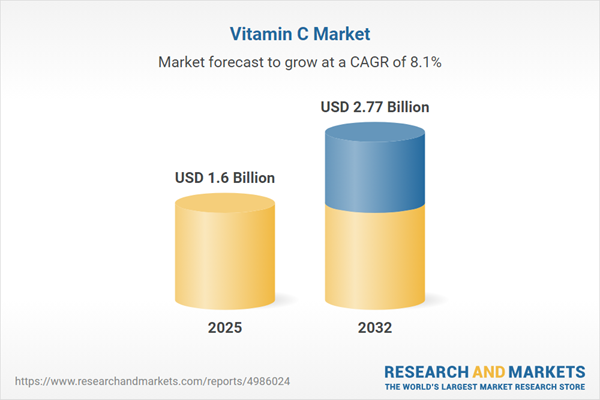Speak directly to the analyst to clarify any post sales queries you may have.
Senior decision-makers in the health, nutrition, and ingredients industries are closely monitoring the vitamin C market’s evolving dynamics, as cross-sector demand and supply strategies reshape global standards for innovation and resilience.
Market Snapshot of the Vitamin C Market
The vitamin C market grew from USD 1.48 billion in 2024 to USD 1.60 billion in 2025. Projected to expand at a CAGR of 8.14%, the market is set to reach USD 2.77 billion by 2032.
Scope & Segmentation: In-depth Coverage of the Vitamin C Market
This report provides a comprehensive view of the vitamin C market’s structure across multiple dimensions and identifies strategic levers impacting innovation and growth:
- Form: Capsules (including hard and soft capsules), effervescent tablets, liquids (injectables and syrups), powders (bulk powders, sachets), and tablets (chewable, film-coated).
- Application: Cosmetics (serums, topical creams), dietary supplements, functional foods & beverages (juices, ready-to-drink, bars, cereals), pharmaceuticals.
- Source: Natural (acerola cherry, blackcurrant, camu camu, rose hips) and synthetic ingredients.
- Distribution Channel: Offline (pharmacies, supermarkets, specialty stores) and online platforms.
- Type: Ascorbic acid, calcium ascorbate, Ester-C, sodium ascorbate.
- Regions: Americas (North and Latin America), Europe, Middle East & Africa, Asia-Pacific—and all strategic sub-markets within.
- Companies Tracked: Koninklijke DSM N.V., BASF SE, Northeast Pharmaceutical Group, Hefei TNJ Chemical Industry, Hubei Grand Pharmaceutical, Zhejiang Medicine, DSM Nutritional Products, Tianjin Northeast Pharmaceutical Group, North China Pharmaceutical Group, Shandong Luwei Pharmaceutical.
Key Takeaways Shaping the Competitive Landscape
- Innovative delivery formats, including on-the-go solutions and stable liquid extracts, address shifting consumer expectations for efficacy and convenience.
- Expanded research into extraction and stabilization technologies enables improved product bioavailability and premium positioning across segments.
- Market players are integrating sustainable ingredient sourcing and eco-friendly packaging to build traceability and respond to regulatory scrutiny.
- Collaborative ventures among manufacturers, ingredient suppliers, and consumer brands fuel open innovation in areas such as cosmeceuticals and functional foods.
- Regional strategies are essential, with North America favoring convenience, Asia-Pacific driving manufacturing scale and exports, and Europe emphasizing regulatory compliance and quality assurance.
- Supply chain resilience is being reinforced through nearshoring and strategic alliances to ensure agility amid regulatory and logistical uncertainties.
Tariff Impact: Implications for Sourcing and Supply Networks
The 2025 imposition of U.S. tariffs on vitamin C raw materials has spurred producers to diversify sourcing and invest in regional manufacturing hubs. High input costs prompted manufacturers to recalibrate sourcing between natural and synthetic variants, optimizing portfolio mix and supply chain strategies. Localized joint ventures and nearshoring have reduced trade and policy risk, while hybrid sourcing approaches help maintain product quality and margin stability.
Methodology & Data Sources
This research employs extensive triangulation, drawing from proprietary databases, industry filings, internal archives, and patent repositories. In-depth interviews with senior executives and technical experts supplement secondary research, ensuring analytical rigor, validated trends, and balanced perspective throughout the report.
Why This Report Matters for Decision-Makers
- Gain actionable clarity on emerging innovation drivers and competitive forces shaping the global vitamin C landscape.
- Identify optimal strategies for supply chain resilience and differentiated market positioning in response to tariff, regulatory, and sustainability shifts.
- Leverage granular regional insights to tailor go-to-market and R&D strategies for maximum impact across differentiated consumer segments.
Conclusion
The vitamin C market is advancing rapidly, shaped by innovation, regulatory adjustments, and evolving consumer expectations. Companies realigning their strategies will be well-positioned for sustained growth in this changing landscape.
Additional Product Information:
- Purchase of this report includes 1 year online access with quarterly updates.
- This report can be updated on request. Please contact our Customer Experience team using the Ask a Question widget on our website.
Table of Contents
3. Executive Summary
4. Market Overview
7. Cumulative Impact of Artificial Intelligence 2025
Companies Mentioned
The companies profiled in this Vitamin C market report include:- Koninklijke DSM N.V.
- BASF SE
- Northeast Pharmaceutical Group Co., Ltd.
- Hefei TNJ Chemical Industry Co., Ltd.
- Hubei Grand Pharmaceutical Co., Ltd.
- Zhejiang Medicine Co., Ltd.
- DSM Nutritional Products
- Tianjin Northeast Pharmaceutical Group
- North China Pharmaceutical Group Corporation
- Shandong Luwei Pharmaceutical Co., Ltd
Table Information
| Report Attribute | Details |
|---|---|
| No. of Pages | 188 |
| Published | October 2025 |
| Forecast Period | 2025 - 2032 |
| Estimated Market Value ( USD | $ 1.6 Billion |
| Forecasted Market Value ( USD | $ 2.77 Billion |
| Compound Annual Growth Rate | 8.1% |
| Regions Covered | Global |
| No. of Companies Mentioned | 11 |









